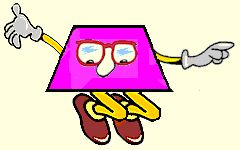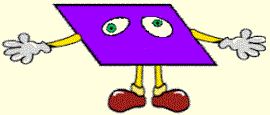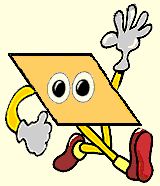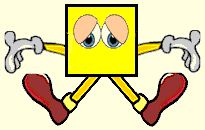Quadrilateral Family
Each member of the quadrilateral family will describe its specific properties.
Quadrilateral
- I have exactly four sides.
- The sum of the interior angles of all quadrilaterals is 360º.

- A quadrilateral is any four sided figure. Do not assume any additional properties for a quadrilateral unless you are given additional information.
Trapezoid
- I have only one set of parallel sides.
[The median of a trapezoid is parallel to the bases and equal to one-half the sum of the bases.]

- A trapezoid has ONLY ONE set of parallel sides. When proving a figure is a trapezoid, it is necessary to prove that two sides are parallel and two sides are not parallel.
Isosceles Trapezoid
- I have: only one set of parallel sides
- base angles congruent
- legs congruent
- diagonals congruent
- opposite angles supplementary

- Never assume that a trapezoid is isosceles unless you are given (or can prove) that information.
Parallelogram
- I have: 2 sets of parallel sides
- 2 sets of congruent sides
- opposite angles congruent
- consecutive angles supplementary
- diagonals bisect each other
- diagonals form 2 congruent triangles

- Notice how the properties of a parallelogram come in sets of twos: two properties about the sides; two properties about the angles; two properties about the diagonals. Use this fact to help you remember the properties.
Rectangle
- I have all of the properties of the parallelogram PLUS
- 4 right angles
- diagonals congruent

- If you know the properties of a parallelogram, you only need to add 2 additional properties to describe a rectangle.
Rhombus
- I have all of the properties of the parallelogram PLUS
- 4 congruent sides
- diagonals bisect angles
- diagonals perpendicular

- A rhombus is a slanted square. It has all of the properties of a parallelogram plus three additional properties.
Square
- I have all of the properties of the parallelogram AND the rectangle AND the rhombus.

- The square is the most specific member of the quadrilateral family. It has the largest number of properties.
